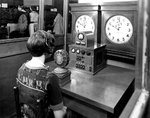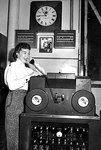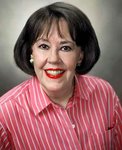syscom3
Pacific Historian
Time of day calling it quits at AT&T
August 29, 2007
Sign Up
It's the end of time, at least as far as AT&T is concerned.
The brief note in customers' bills hardly does justice to the momentousness of the decision. "Service withdrawal," it blandly declares. "Effective September 2007, Time of Day information service will be discontinued."
What that means is that people throughout Southern California will no longer be able to call 853-1212 to hear a woman's recorded voice state that "at the tone, Pacific Daylight Time will be . . ." with the recording automatically updating at 10-second intervals.
"Times change," said John Britton, an AT&T spokesman. "In today's world, there are just too many other ways to get this information. You can look at your cellphone or your computer. You no longer have to pick up the telephone."
Indeed, time already has stopped in 48 other states, he said. California and Nevada are the two remaining holdouts.
In Northern California, the prefix for calling time is 767, or P-O-P on a telephone keypad. For decades, locals up there have dialed POPCORN any time they have had to reset their watches or reprogram electronic gadgets after a power failure.
"In California, our equipment has gotten old," Britton said. "It's reached the end of its life span."
Time's up statewide Sept. 19. Britton said Nevada service would live on borrowed time for an unspecified period, until the equipment in that state similarly starts breaking down.
One upside: AT&T says doing away with time would enable the creation of about 300,000 new phone numbers in California beginning with the 853 or 767 prefixes. (No such numbers have been issued to date because, when coupled with any four other digits, you get time.)
To be sure, time marches on. Yet for many Californians, the looming demise of the "time lady," as she's come to be known, marks the end of a more genteelera, when we all had time to share.
"It was always there," said Orlo Brown, 70, who for many years kept Pacific Bell's (and subsequently SBC's) time machines running in a downtown Los Angeles office building. "Everybody knew the number."
Richard Frenkiel was assigned to work on the time machines when he joined Bell Labs in the early 1960s. He described the devices as large drums about 2 feet in diameter, with as many as 100 album-like audio tracks on the exterior. Whenever someone called time, the drums would start turning and a message would begin, with different tracks mixed together on the fly.
"The people who worked on it took it very seriously," Frenkiel, 64, recalled. "They took a lot of pride in it."
In a twist of historical irony, Frenkiel went on to play a leading role in development of the technology that makes cellphones possible -- the very device that's now instrumental in killing time.
Phone companies have been providing the time to callers since the 1920s. In the early days, live operators read the time off clocks on the wall.
In the 1930s, an Atlanta company called Audichron devised a system for the time to be provided automatically. Audichron leased its technology to phone companies nationwide, often with sponsorship from local businesses.
Time ladies -- and a few gentlemen -- came and went over the years. Then, in the 1950s, a woman named Mary Moore emerged as the nation's leading time-teller.
Her reading of hours, minutes and seconds was delivered in a distinctive if somewhat prissy tone. Moore's odd pronunciation of the numbers 5 ("fiyev") and 9 ("niyun") influenced a generation of operators, much as flying ace Chuck Yeager's West Virginia drawl is said to have been adopted by innumerable airline pilots.
By far the most prominent time lady was Jane Barbe, who succeeded Moore at Audichron in the 1960s. A former big band singer, Barbe (pronounced "Barbie") went on to become the voice of recorded telephone messages in the 1970s and '80s in the United States and elsewhere.
Along with her interpretations of the time and current temperature, Barbe delivered the bad news too, telling you that circuits in a specific area were busy, please try again later, or that your call cannot be completed as dialed.
And who will ever forget her heartbreaking rendition of "I'm sorry, the number you have dialed is no longer in service"?
Barbe died of cancer-related complications in 2003 at age 74. It's estimated that at the height of her fame, Barbe's voice was heard worldwide about 40 million times a day.
AT&T's Britton said the company started using Audichron's machines in 1948 and then switched to a different system manufactured by rival Weatherchron, also of Atlanta, in the 1960s. He was unable to identify the current time lady, saying that perhaps no one at AT&T knows who she is.
Ellis Bryant, the 83-year-old president of Weatherchron, also was unsure whose voice Californians hear when they call time. So he dialed 853-1212 and listened to the recording.
"Oh, that's Joanne," Bryant said without hesitation. "Joanne Daniels. No doubt about it."
He said Daniels started recording the time for Weatherchron about 25 years ago. At some point after Pacific Bell switched to his company's system, Daniels became California's time lady.
Reached at her Atlanta home, Daniels, 65, estimated that her reach was once nearly as extensive as that of Barbe, who was a friend. Daniels is now retired.
"I've done the time in many areas -- Eastern Standard Time, central time, Pacific time," she said. "The fun part was doing the temperatures for places like Alaska."
Daniels switched to her professional voice, her soft Southern accent instantly vanishing. "At the tone," she said, "the temperature is minus 12 degrees." She laughed and her accent returned. "I liked that."
No one had told her that AT&T was about to stop time.
"I think that's very sad," Daniels said. "I was told at one time that my voice would last until well into the 21st century. Now it looks like I'm about to be laid to rest."
When that day comes, Daniels said, she knows what her epitaph will be: "She knew the time."
Consumer Confidential runs Wednesdays and Sundays. Send tips or feedback to [email protected].
August 29, 2007
Sign Up
It's the end of time, at least as far as AT&T is concerned.
The brief note in customers' bills hardly does justice to the momentousness of the decision. "Service withdrawal," it blandly declares. "Effective September 2007, Time of Day information service will be discontinued."
What that means is that people throughout Southern California will no longer be able to call 853-1212 to hear a woman's recorded voice state that "at the tone, Pacific Daylight Time will be . . ." with the recording automatically updating at 10-second intervals.
"Times change," said John Britton, an AT&T spokesman. "In today's world, there are just too many other ways to get this information. You can look at your cellphone or your computer. You no longer have to pick up the telephone."
Indeed, time already has stopped in 48 other states, he said. California and Nevada are the two remaining holdouts.
In Northern California, the prefix for calling time is 767, or P-O-P on a telephone keypad. For decades, locals up there have dialed POPCORN any time they have had to reset their watches or reprogram electronic gadgets after a power failure.
"In California, our equipment has gotten old," Britton said. "It's reached the end of its life span."
Time's up statewide Sept. 19. Britton said Nevada service would live on borrowed time for an unspecified period, until the equipment in that state similarly starts breaking down.
One upside: AT&T says doing away with time would enable the creation of about 300,000 new phone numbers in California beginning with the 853 or 767 prefixes. (No such numbers have been issued to date because, when coupled with any four other digits, you get time.)
To be sure, time marches on. Yet for many Californians, the looming demise of the "time lady," as she's come to be known, marks the end of a more genteelera, when we all had time to share.
"It was always there," said Orlo Brown, 70, who for many years kept Pacific Bell's (and subsequently SBC's) time machines running in a downtown Los Angeles office building. "Everybody knew the number."
Richard Frenkiel was assigned to work on the time machines when he joined Bell Labs in the early 1960s. He described the devices as large drums about 2 feet in diameter, with as many as 100 album-like audio tracks on the exterior. Whenever someone called time, the drums would start turning and a message would begin, with different tracks mixed together on the fly.
"The people who worked on it took it very seriously," Frenkiel, 64, recalled. "They took a lot of pride in it."
In a twist of historical irony, Frenkiel went on to play a leading role in development of the technology that makes cellphones possible -- the very device that's now instrumental in killing time.
Phone companies have been providing the time to callers since the 1920s. In the early days, live operators read the time off clocks on the wall.
In the 1930s, an Atlanta company called Audichron devised a system for the time to be provided automatically. Audichron leased its technology to phone companies nationwide, often with sponsorship from local businesses.
Time ladies -- and a few gentlemen -- came and went over the years. Then, in the 1950s, a woman named Mary Moore emerged as the nation's leading time-teller.
Her reading of hours, minutes and seconds was delivered in a distinctive if somewhat prissy tone. Moore's odd pronunciation of the numbers 5 ("fiyev") and 9 ("niyun") influenced a generation of operators, much as flying ace Chuck Yeager's West Virginia drawl is said to have been adopted by innumerable airline pilots.
By far the most prominent time lady was Jane Barbe, who succeeded Moore at Audichron in the 1960s. A former big band singer, Barbe (pronounced "Barbie") went on to become the voice of recorded telephone messages in the 1970s and '80s in the United States and elsewhere.
Along with her interpretations of the time and current temperature, Barbe delivered the bad news too, telling you that circuits in a specific area were busy, please try again later, or that your call cannot be completed as dialed.
And who will ever forget her heartbreaking rendition of "I'm sorry, the number you have dialed is no longer in service"?
Barbe died of cancer-related complications in 2003 at age 74. It's estimated that at the height of her fame, Barbe's voice was heard worldwide about 40 million times a day.
AT&T's Britton said the company started using Audichron's machines in 1948 and then switched to a different system manufactured by rival Weatherchron, also of Atlanta, in the 1960s. He was unable to identify the current time lady, saying that perhaps no one at AT&T knows who she is.
Ellis Bryant, the 83-year-old president of Weatherchron, also was unsure whose voice Californians hear when they call time. So he dialed 853-1212 and listened to the recording.
"Oh, that's Joanne," Bryant said without hesitation. "Joanne Daniels. No doubt about it."
He said Daniels started recording the time for Weatherchron about 25 years ago. At some point after Pacific Bell switched to his company's system, Daniels became California's time lady.
Reached at her Atlanta home, Daniels, 65, estimated that her reach was once nearly as extensive as that of Barbe, who was a friend. Daniels is now retired.
"I've done the time in many areas -- Eastern Standard Time, central time, Pacific time," she said. "The fun part was doing the temperatures for places like Alaska."
Daniels switched to her professional voice, her soft Southern accent instantly vanishing. "At the tone," she said, "the temperature is minus 12 degrees." She laughed and her accent returned. "I liked that."
No one had told her that AT&T was about to stop time.
"I think that's very sad," Daniels said. "I was told at one time that my voice would last until well into the 21st century. Now it looks like I'm about to be laid to rest."
When that day comes, Daniels said, she knows what her epitaph will be: "She knew the time."
Consumer Confidential runs Wednesdays and Sundays. Send tips or feedback to [email protected].



